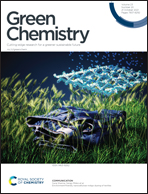Furfurylation protects timber from degradation by marine wood boring crustaceans†
Abstract
Unmodified timber is susceptible to biodegradation in the marine environment by wood-boring molluscs and crustaceans. Wood is a renewable resource and has a much lower carbon footprint than other alternative materials that are suitable for marine applications, such as concrete and steel. However, biodegradation causes expensive damage to wooden structures and protection by broad spectrum biocides entails environmental risks. Furfurylation offers an effective alternative protection from marine wood-borers. We investigate the changes in feeding rate, behaviour and digestion of the marine wood-boring crustacean, the gribble, on furfurylated wood under laboratory conditions. Pinus radiata was impregnated with furfuryl alcohol in a methanol solvent and polymerised at elevated temperatures. Wood was leached in seawater and then tested in a laboratory setting against the gribble Limnoria quadripunctata, by measuring its feeding rate (faecal pellet production), vitality and mortality. The wood samples were analysed using Attenuated Total Reflectance Infrared Spectroscopy (ATR-IR), while faecal pellets were analysed by Atomic Force Microscopy Infrared Spectroscopy (AFM-IR). A reduction in band intensity ascribed to carbonyl vibration was seen during leaching, possibly due to loss of hemicellulose or acetyl groups therein. Untreated wood faecal pellets showed a decrease in C–O absorbance in the 1100–1000 cm−1 range interpreted as a loss of cellulose and an increase in signal in the 1700–1600 cm−1 range interpreted as increase in lignin modification products. For furfurylated wood similar tendencies were seen, but to a smaller extent. Faecal pellet production was reduced on treated wood and a lack of burrowing behaviour was observed. Mortality began to increase after a month of decreased feeding rates which is comparable to mortality rates of starved gribble. Disruption to enzymatic activity within the gut and/or increased hardness of the wood could be the mechanisms protecting furfurylated wood from biodegradation by gribble. Modification of wood, such as by furfurylation, offers promising levels of protection against such degradation without the reliance on broad spectrum biocides and can reduce costs associated with damaged wooden structures.

- This article is part of the themed collections: 2021 Green Chemistry Hot Articles and Biobased furanic derivatives for sustainable development


 Please wait while we load your content...
Please wait while we load your content...